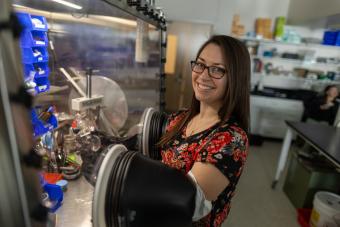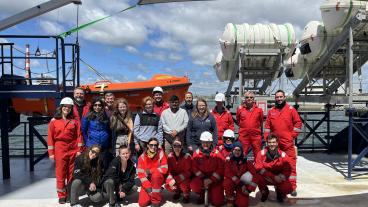Annalise Maughan wins NSF CAREER Award for new materials research
Maughan’s research focuses on discovering ideal materials for solid-state batteries

Annalise Maughan, assistant professor of chemistry at Colorado School of Mines, has received a National Science Foundation CAREER Award for her work to discover materials for use in solid-state batteries.
In traditional lithium-ion batteries, lithium ions move back and forth through an electrolyte layer, which is typically liquid. While efficient, these liquids have a trade-off—they are often flammable.
Solid-state batteries are a newer type of battery that replaces the liquid electrolyte with a solid-state ion conductor. Maughan’s CAREER research is focused on a particular sulfide mineral in the argyrodite family.
“We think a lot about what materials design principles make solid-state ion transport very fast,” Maughan said.
Maughan’s NSF award of $791,698 covers five years of research to develop new materials that could change the way dynamics and ion transport are understood. Here, Maughan answers a few questions about her latest research:
Q: What do you find most exciting about your research?
Maughan: I am really passionate about discovering new materials. In materials science, we often take materials that we know exist and then ask, “How can we change the chemistry to find new materials that haven’t been discovered?” I love that aspect of materials discovery.
I also love building connections between structure, bonding, and dynamics. How are the atoms bonded? How are those bonds arranged? How are the atoms moving? We often think of atoms in solids being “stuck” – but at the atomic level, things are moving. The connection between structures and how the atoms are arranged, how they’re moving in the structure, and then how that relates to some sort of property – those to me are the coolest things to study and what I’m really excited about exploring.
Q: What is the potential impact of this work?
Maughan: The way ions are transported in the solid state has been an ongoing open question in the literature. The process is complex and is impacted by a lot of conflating factors. This work seeks to untangle these effects and develop an entirely new family of materials that has never been discovered. The hope then is that when we understand deeply how all these things come together and how ion movement happens. If we understood these connections, we could design better materials for solid-state batteries in the future.
Q: How does this research agenda inform your teaching?
Maughan: I have recently developed a new elective course at the graduate level with a cross listing for an undergraduate course called solid-state chemistry. That course emphasizes a deep intuition and understanding of structure and dynamics and seeks to teach students how to read literature, rather than a traditional classroom based on lectures and homework. The course is structured as a seminar-style literature review. We all read the same paper, I have them fill out a scaffolded worksheet that helps them identify hypotheses and questions. Then we discuss as a class if the hypotheses posed were addressed fully based on the presented data. I really try to teach students how to think critically about the literature and that has been a big effort. I really like an inquiry-based approach where students are getting to ask their own questions rather than being told what they should ask.
Q: How do you plan to expand your outreach on these topics?
Maughan: I am planning on developing a series of kits for instructional use in high school and middle school classrooms called the Materials Mystery Detective Game. The goal is to provide students with a series of unknown materials that have different structures and properties – such as electronic conductivity, magnetism, color, luminescence, etc. Students can experiment and test these properties using provided tools to discover what the materials could be. We will also provide material science teaching tools. If a material is very ductile, there is a structural reason for that based on the arrangement of atoms. We are developing a series of toys and demos that illustrate how that atomic arrangement and movement impacts mechanical properties. I hope to encourage students to get really creative and curious to figure out what structures give rise to what properties.
Another aspect of my educational outreach is developing a video series. The goal of this video series is to present key concepts in solid state materials chemistry, but at three different technical levels within a single video. We will have a technical explanation that’s geared toward high school students, a technical explanation geared toward college students who have some chemistry background but no familiarity with solid-state chemistry concepts, and then a third for students at a graduate level trying to learn the concepts more deeply. By doing all this in the same video, I hope to bridge the gap between technical expertise and broader understanding to the field.




